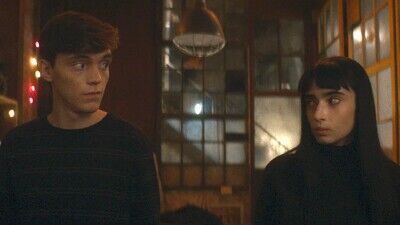Young Québecois-based vampire Sasha (Lilas-Rose Cantin) never had any urge to suck human flesh, unlike her bloodthirsty family. One specific incident on her birthday involving a clown family buffet she was too startled to participate in leaves her with profound PTSD that neurologically affects her. Now, the desire she would’ve had for blood has been overtaken by empathy, preventing her fangs from forming.
Despite her pacifistic soul and lack of fangs, Sasha still has an appetite for blood. As she ages into a teenage vampire—68 in human years presenting as a human teen— Sasha (Sara Montpetit) still lives at home with her parents (Steve Laplante and Sophie Cadieux), freeloading off their Capri-sun-shaped blood pouches. Tired of her not contributing to their household’s food storage, her parents force Sasha to live with her cold-yet-chic older cousin Denise (Noémie O’Farrell), hoping she will teach her how to hunt humans.
Meanwhile, Paul (Félix-Antoine Bénard) is on the opposite end of the same coin. He’s a hapless, socially anxious teen who’s bullied by everyone, from his peers to his principal. He works at a bowling alley alongside his main tormenter, Henry (Arnaud Vachon).
One evening, Sasha sees Paul contemplating suicide on top of his job’s roof, but he doesn’t follow through. Curiously, Sasha follows him into a crane yard and startles him with her vampire qualities, and he runs into a crate. As fate would have it, soon Sasha and Paul’s world collide at a suicide help group where they form a pact, offering Sasha his blood so she could eat without moral guilt, and he could die.
The film digs its fangs into Sasha’s vampiric individualism while illustrating her entrapment caused by their conflicting circumstances, which she can’t control—similar to, say, Remy and his desire to cook in a rat-killing society or Luca wanting to experience being a kid despite his sea monster identity. For Sasha, it’s her desire for her fangs to drop and fit into her family unit without having to kill another human being.
Seemingly inspired by the progressiveness of today’s Gen-Z culture clashing with one of the most murderous mythological creatures, Sasha’s problem is well-depicted. Louis-Seize stylishly personalizes Sasha’s worldview (toying with lighting and sound to signal Sasha’s inner desires or verbalize her enclosed loneliness) while leaving room for subtlety. The same sentiment applies to Sasha’s emotional therapy human friend Paul, whose loneliness and longing for depth are also resonant and explored. While not as intriguing as Sasha, Louis-Seize and Christine Doyon’s script does sizable work in meeting them in the middle and flaring their connection.

